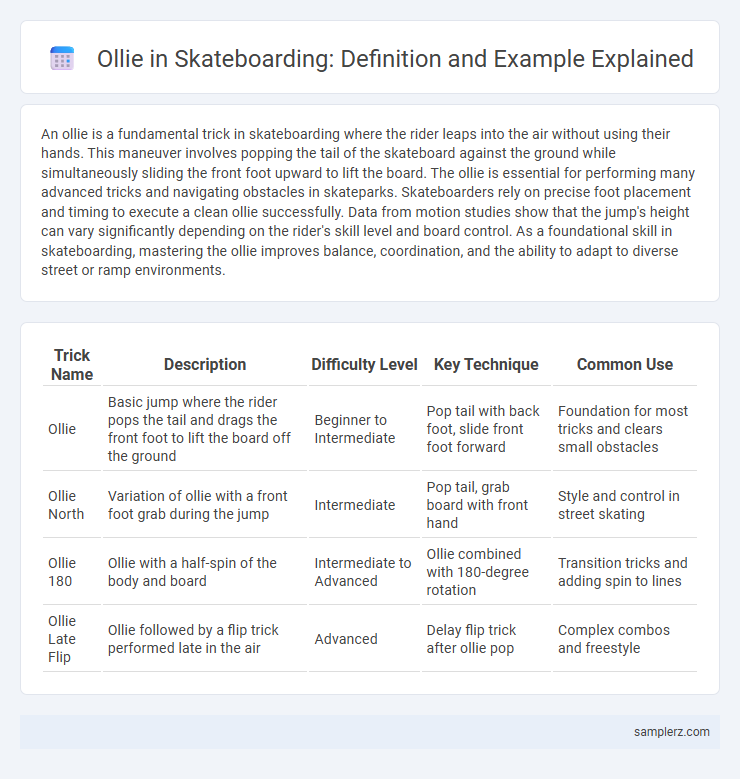An ollie is a fundamental trick in skateboarding where the rider leaps into the air without using their hands. This maneuver involves popping the tail of the skateboard against the ground while simultaneously sliding the front foot upward to lift the board. The ollie is essential for performing many advanced tricks and navigating obstacles in skateparks. Skateboarders rely on precise foot placement and timing to execute a clean ollie successfully. Data from motion studies show that the jump's height can vary significantly depending on the rider's skill level and board control. As a foundational skill in skateboarding, mastering the ollie improves balance, coordination, and the ability to adapt to diverse street or ramp environments.
Table of Comparison
| Trick Name | Description | Difficulty Level | Key Technique | Common Use |
|---|---|---|---|---|
| Ollie | Basic jump where the rider pops the tail and drags the front foot to lift the board off the ground | Beginner to Intermediate | Pop tail with back foot, slide front foot forward | Foundation for most tricks and clears small obstacles |
| Ollie North | Variation of ollie with a front foot grab during the jump | Intermediate | Pop tail, grab board with front hand | Style and control in street skating |
| Ollie 180 | Ollie with a half-spin of the body and board | Intermediate to Advanced | Ollie combined with 180-degree rotation | Transition tricks and adding spin to lines |
| Ollie Late Flip | Ollie followed by a flip trick performed late in the air | Advanced | Delay flip trick after ollie pop | Complex combos and freestyle |
Understanding the Ollie: Skateboarding’s Fundamental Trick
The ollie, a foundational skateboarding trick, involves popping the tail of the board off the ground while jumping and leveling the board mid-air using the front foot. Mastery of the ollie enables skaters to perform various advanced tricks such as kickflips and heelflips, influencing overall skateboarding progression. Proper technique emphasizes timing, foot placement, and balance, making it essential for beginners aiming to improve their skateboarding skills.
History and Evolution of the Ollie in Skateboarding
The ollie, invented by Alan Gelfand in the late 1970s, revolutionized skateboarding by introducing a no-hands aerial technique that allowed riders to leap over obstacles. As skateboarding evolved through the 1980s and 1990s, the ollie became the foundational move for street skating, enabling complex tricks like kickflips and heelflips. Today, it remains a core skill for skateboarders, symbolizing the sport's innovation and progression.
Key Steps to Perform a Successful Ollie
The key steps to perform a successful ollie in skateboarding include popping the tail of the skateboard down with the back foot to create lift, sliding the front foot forward to level the board in mid-air, and maintaining balance by keeping your shoulders aligned with the skateboard. Timing the pop and slide motion correctly ensures height and control during the jump. Consistent practice on these coordinated movements develops fluidity and stability essential for advanced skateboarding tricks.
Common Mistakes Beginners Make When Learning Ollies
Beginners learning ollies often struggle with improper foot placement, which reduces lift and balance during the trick. Another common mistake is failing to time the pop and slide simultaneously, resulting in weak or incomplete ollies. Inconsistent commitment to snapping the tail of the board also leads to low height and missed obstacles.
Expert Tips to Perfect Your Ollie Technique
Mastering the ollie in skateboarding requires precise timing, with the back foot snapping down hard on the tail while the front foot slides up to level the board mid-air. Maintaining a low center of gravity and bending your knees optimizes balance and control throughout the jump. Consistent practice on varied surfaces enhances muscle memory and builds the necessary pop strength to execute higher and smoother ollies.
Essential Gear for Practicing Ollies Safely
Wearing a properly fitted skateboard helmet and impact-resistant wrist guards significantly reduces injury risks during ollie practice. High-top skate shoes with grippy soles provide essential ankle support and board control for executing clean ollies. Durable knee and elbow pads protect joints from falls, enabling safer and more confident skill development.
Famous Skateboarders Known for Iconic Ollies
Skateboarding legends like Rodney Mullen and Tony Hawk revolutionized the sport with their iconic ollies, showcasing unparalleled technical precision and creativity. Rodney Mullen, often credited as the "Godfather of Street Skateboarding," popularized the ollie in flatground tricks, while Tony Hawk elevated it in vert skateboarding with his smooth execution. Their contributions have cemented the ollie as a fundamental trick that continues to inspire generations of skateboarders worldwide.
The Importance of Ollies in Street and Park Skateboarding
Ollies serve as the foundational skill in street and park skateboarding, enabling riders to perform various tricks by lifting the board off the ground without using their hands. Mastery of ollies enhances balance, control, and versatility needed to navigate urban obstacles like stairs, rails, and ledges. Skateboarders rely heavily on ollies to build complex trick combinations and maintain momentum across diverse terrain in both competitive and recreational settings.
Progressing from Ollies to Advanced Skateboard Tricks
Mastering the ollie is essential for progressing to advanced skateboard tricks like kickflips, heelflips, and 360 flips. Increasing pop height and board control during ollies builds the foundation for technical street and park skating maneuvers. Consistent ollie practice improves timing and balance, crucial for executing complex tricks with precision and style.
Inspiring Video Examples of Ollies Performed by Pros
Skateboarding pros like Rodney Mullen and Nyjah Huston demonstrate flawless ollies in videos that showcase precision and style, inspiring both beginners and experts. These clips highlight the timing, pop, and board control essential to mastering the trick. Viewers can learn the nuanced foot placement and airborne balance that elevate the ollie from a basic move to an art form.

example of ollie in skateboarding Infographic
 samplerz.com
samplerz.com